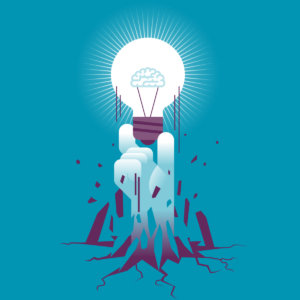What Sets Breakthrough Strategies Apart
Innovative strategies depend more on novel, well-reasoned theories than on well-crunched numbers.
Strategy advice has taken a rather negative tone of late. Consultants and scholars alike seem obsessed with eradicating bias and error in human judgment and decision-making. A virtual cottage industry has emerged to offer advice how to do that, often pushing managers to replace flawed human judgment with big data analytics and various computational tools. Given this abysmal view of human judgment, it’s no wonder that some authors have suggested that algorithms and artificial intelligence (AI) should play a greater role in strategic decisions.
No doubt bias and error are important concerns in strategic decision-making. Yet it seems quite a stretch to suggest that the original strategies developed by people like Apple’s Steve Jobs, Starbucks’ Howard Schultz, or even Walmart’s Sam Walton had much to do with error-free calculations based on big data. Their strategies, like most breakthrough strategies, emerged in settings with remarkably little data to process and little basis for calculation — situations in which the paths to value creation were highly uncertain and evidence was sparse. We are highly skeptical that debiasing decision-making, eradicating errors, or ceding strategy to AI will improve strategizing, let alone lead to breakthrough strategies.
What Do You See?
Composing valuable strategies requires seeing the world in new and unique ways. It requires asking novel questions that prompt fresh insight. Even the most sophisticated, deep-learning-enhanced computers or algorithms simply cannot generate such an outlook.
But where does the uniqueness and novelty so essential to innovative strategic thinking come from? It comes from contrarian, perhaps even “distorted,” perceptions and beliefs about reality and the “facts” that surround us. We think that venture capitalist and PayPal cofounder Peter Thiel gets it roughly right when he asks prospective entrepreneurs to tell him something they believe is true that nobody agrees with them about. If everyone believes the same thing — or if everyone uses the same variables, information, and computational tools — the logical result is computational consistency, shared conclusions, and me-too strategies. Thus, while renowned behavioral economist Daniel Kahneman and his coauthors Andrew M. Rosenfield, Linnea Gandhi, and Tom Blaser argued in a 2016 Harvard Business Review article that it is problematic that professionals “often make decisions that deviate significantly from those of their peers,” it is this seeming pathology that provides the underlying raw material — the essential ingredient — for valuable strategies.


Comments (2)
Adrian Jobson
Kheepe Moremi